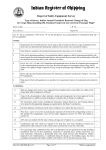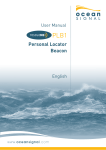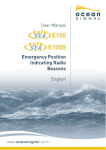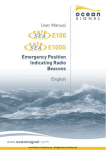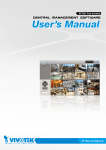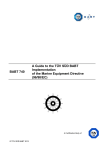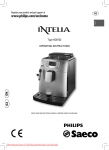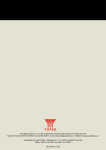Download MGN 499 Life saving appliances
Transcript
Maritime and Coastguard Agency LogMARINE GUIDANCE NOTE MGN 499 (M+F) Life Saving Appliances: Inflatable Liferafts, Marine Evacuation Systems, Inflatable Lifejackets and Hydrostatic Release Units - Servicing Requirements. Notice to all Owners, Operators and Masters of Merchant Ships, Owners and Skippers of Fishing Vessels, Code Vessels, Yachtsmen, Manufacturers and Service Station Personnel. This notice replaces MGN 362(M+F) PLEASE NOTE:Where this document provides guidance on the law it should not be regarded as definitive. The way the law applies to any particular case can vary according to circumstances - for example, from vessel to vessel and you should consider seeking independent legal advice if you are unsure of your own legal position. Summary. Life-saving appliances should be regularly serviced at an approved service station. ● Inflatable liferafts, marine evacuation systems, inflatable lifejackets and hydrostatic release units carried on United Kingdom ships and fishing vessels are required to be regularly serviced at an Approved Service Station ● An ‘approved service station’ is one that has been formally accredited by the manufacturer of the equipment and has been approved by the National Administration. In the UK this is the Maritime and Coastguard Agency on behalf of the Secretary of State. 1. Approved Service Stations 1.1 An 'approved service station' is one that has been formally accredited by the manufacturer and has been approved by the National Administration (in the UK this is the Maritime and Coastguard Agency (MCA) on behalf of the Secretary of State). It has certificated personnel who have been trained to undertake servicing and repairs, and also to repack inflatable liferafts ready for operational use; it carries genuine spares and is kept fully informed of the current servicing procedures by the manufacturer. 1 1.2 Approval of the service stations is conducted in accordance with IMO Resolution A.761(18), as amended – “Recommendations on Conditions for the approval of Servicing Stations for Inflatable Liferafts". 1.3 Service Suppliers should gain manufacturers accreditation before requesting a survey from the MCA to become an 'approved service station'. Subsequent periodic inspections will be conducted by the MCA to maintain approval. 1.4 Manufacturers must notify the MCA in writing with details of any changes to their UK approved service stations. 1.5 Before putting equipment into a service station, Masters or Owners should check the continued approval of the station, and that their make and model of equipment is able to be serviced. A list of ‘approved service stations’ in the UK, is available online at the MCA website http://www.dft.gov.uk/mca/mcga07-home/shipsandcargoes/mcgashiptype/ssb_lif_sav_appliance_serv_stations.htm 1.7 Where a vessel is carrying a liferaft which needs servicing, but it is not manufactured by one of the companies with a UK service station, the Owner, Master or Agent should contact manufacturer to establish the location of the approved service stations. 1.6 Small craft inflatable liferafts (i.e. other than those used on Merchant Ships, Fishing Vessels & Small Commercial Vessels) are recommended to be serviced at an approved service station. ANNEX 2 contains the agreed “Standards for the Conditions for the Approval of Service Stations for Small Craft Inflatable Liferafts”. 2. Service Intervals 2.1 With the exception of small commercial vessel liferafts (see 2.2 below), equipment listed in the summary should be serviced annually and every effort should be made to ensure that it is carried out on time. In exceptional cases, when it is clearly impracticable to comply with this annual servicing requirement, the servicing may be deferred for a period not exceeding 5 months. In such cases, Masters or Owners must apply to their local Maritime and Coastguard Agency’s (MCA) Marine Office, explaining their reason in writing for seeking deferment. 2.2 Inflatable liferafts on ‘small commercial vessels’ (those vessels certified under the MCA’s Small Commercial Vessel Codes of Practice), except those liferafts described in 2.3, below, should be serviced at a service station accredited by the manufacturer and at the manufacturer’s recommended intervals. 2.3 ORC liferafts (ISAF OSR Appendix 1 Part 1), and all liferafts stored in valises, should be serviced at least annually at a service station accredited by the manufacturer. 2.4 The International Sailing Federation (ISAF) Offshore Special Regulations (OSR Appendix A, Part 2) liferaft standard has been replaced with the ISO 9650 – Small Craft Inflatable Liferafts standard. MCA accepts liferafts meeting Part 1, Type 1, Group A of the ISO 9650 standard on small commercial vessels that proceed up to 60 nautical miles from a safe haven, provided the liferaft(s) are fitted with a boarding ramp and equipped to the level of a “SOLAS B PACK”. They must be serviced in accordance with 2.2 above. 2.5 Further to 2.4 above, MCA will also accept such liferafts used on small commercial vessels proceeding more than 60 nautical miles and up to 150 nautical miles from a safe haven, but they must additionally be certified as compliant with ISO 9650 Part 1, -2- Type 1, Group A, equipped to the level of a “SOLAS A PACK” and stowed in a hard canister. Compliance certification issued by one of the EC Notified Bodies responsible for approval of life saving appliances described in the Marine Equipment Directive (MED) (see www.mared.org) will be recognised as full third party verification of compliance. 2.6 Inflatable lifejackets on small commercial vessels should be serviced at a service station accredited by the manufacturer within one month either side of the compliance, renewal and intermediate examinations of the vessel, (or serviced annually if preferred by the vessel owner). In the intervening years they are to be examined annually to the manufacturer’s recommendation. 2.7 Vessels certificated under MSN 1823 shall have their liferafts serviced in accordance with the manufacturer's instructions, at an approved service station, and at least twice in every 5 year period for the first 10 years of service life. The maximum period between services shall be 3 years. Thereafter, such liferafts shall be serviced annually, in accordance with the manufacturer's instructions. Inflatable lifejackets shall be serviced in accordance with the manufacturer’s instructions, at an approved service station, and at least every 2 years. Where any inflatable lifejackets are used on a regular basis, they shall be serviced annually. 2.8 At every biennial servicing, or servicing interval referred to in paragraph 3.2, of a davit launched inflatable liferaft, a 10% overload static load test is to be carried out with the liferaft suspended from its lifting hook or bridle, in accordance with the manufacturer’s approved servicing instructions. 3. Service Interval Exemptions 3.1 The MCA has granted an exemption to the annual servicing of Open Reversible Liferafts (ORLs) fitted to Class III to VI(A) passenger vessels. This is shown in ANNEX 1. This allows omitting the 2nd year, 4th year, 6th year and 8th year from annual servicing interval. The Schedule to this general exemption specifically indicates the particular servicing intervals and test methods applicable to ORLs fitted on the above passenger ships. This exemption does not apply to ORLs fitted to high-speed craft or to canopy “SOLAS” type liferafts fitted to the above Classes of vessels. 3.2 A further exemption granted by the MCA, allows servicing intervals of up to 30 months for particular equipment when it is specially packed to allow for extended service intervals. These rafts will either be MCA Approved & Certificated or are required to comply with the requirements of IMO Circular MSC.1/Circ.1328. These liferafts will have details of the extended service interval on their Marine Equipment Directive certificate. Operators are reminded that although servicing is only required at extended service intervals (not exceeding 30 months), MSC.1/Circ.1328 requires an annual onboard inspection to be undertaken by qualified persons, who have been adequately trained and certificated by the liferafts manufacturer. Information regarding equivalent arrangement for extended servicing intervals of inflatable liferafts is available online at the MCA website http://www.dft.gov.uk/mca/mcga07-home/shipsandcargoes/mcgashiptype/ssb_lif_sav_appliance_serv_stations.htm 4. Hydrostatic Release Units (HRUs) 4.1 There have been incidences of incorrectly installed HRUs, resulting in a compromise of the float-free arrangements of the liferaft. The liferaft and HRUs should be installed strictly in accordance with the approved manufacturer's instructions. Details of the -3- correct installation procedure of the HRU to the liferaft should be provided with each unit supplied. Requirements for onboard stowage of inflatable liferafts together with hydrostatic release units are contained in Marine Guidance Note MGN 343 (M+F). 5. Other Information 5.1 Internationally, through the provisions of SOLAS, National Administrations carry out the approval of servicing stations within their jurisdiction, irrespective of whether or not that particular Administration has approved the subject product(s). 5.2 It is an offence to carry an inflatable liferaft, marine evacuation system, inflatable lifejacket or hydrostatic release unit which is known to be defective, or which has not been serviced at the intervals prescribed by the Regulations. Each of the above equipment shall have a full service history, which shall be available on board the vessel for inspection by all the relevant authorities. 5.3 This MGN is applicable to all inflatable liferafts, marine evacuation systems, inflatable lifejackets and hydrostatic release units required to be carried on board United Kingdom ships, and is not limited to ‘SOLAS’ or Marine Equipment Directive (MED) standard equipment. 5.4 During re-installation of rafts after servicing, service providers and operators should be mindful of specially configured rafts eg. ‘handed’, where painter and bowsing lines are customised and may vary in length for the specific stowage location on the vessel. Correct re-installation on the vessel is paramount to the safe operation of the raft in an emergency. 5.5 This MGN can be found on the MCA website at http://www.dft.gov.uk/mca under Ships and Cargoes/Legislation and Guidance/Marine (M) Notices/MGNs. More Information Marine Technology Branch Maritime and Coastguard Agency, Bay 2/27 Spring Place, 105 Commercial Road, Southampton, SO15 1EG. Tel : e-mail: +44 (0) 23 8032 9100. [email protected]. General Inquiries: [email protected] . MCA Website Address: www.dft.gov.uk/mca . File Ref: MS 3/14/862 Published: November 2013 Please note that all addresses and telephone numbers are correct at time of publishing. © Crown Copyright 2013. Safer Lives, Safer Ships, Cleaner Seas. -4- ANNEX 1 GENERAL EXEMPTION THE MERCHANT SHIPPING (LIFE-SAVING APPLIANCES FOR PASSENGER SHIPS OF CLASSES III TO VI(A) REGULATIONS 1999 The Secretary of State in exercise of his power under regulation 23 of the Merchant Shipping (Life-Saving Appliances for Passenger Ships of Classes III to VI(A) Regulations 19991; hereby exempts ships to which the Regulations apply from the requirement of regulation 11(7) that requires open reversible liferafts, complying with the requirements of Schedule 4, Part II of the said Regulations, to be serviced at intervals not exceeding 12 months, subject to the following conditions that: 1. such open reversible liferafts shall be serviced; (a) at intervals not exceeding two years; and (b) within the periods stated in the attached Schedule, such periods being measured from the date of manufacture; and 2. the servicing includes the test methods stated in the attached Schedule according to the age of the open reversible liferaft. This exemption shall not apply to open reversible liferafts carried on High Speed Craft. This exemption, which may be cancelled or modified at any time, shall otherwise remain in force until 31 May 2020. Dated this [date to be inserted] Mr Philip Naylor For the Secretary of State 1 SI 1999/2723 -5- ANNEX 1 SCHEDULE SERVICING INTERVALS AND TEST METHODS FOR OPEN REVERSIBLE LIFERAFTS CARRIED ON PASSENGER SHIPS OF CLASSES III TO VI(A) Servicing intervals Test method End of first year End of third year End of fifth year End of seventh year End of ninth year End of tenth year Eleventh to fourteenth year Fifteenth year Sixteenth to nineteenth year Twentieth year Twenty-first to twenty-fourth year Twenty-fifth year Etc. WP test WP test GI test WP test WP test GI test + FS NAP test + FS GI test + NAP + FS NAP test + FS GI test + NAP + FS NAP test + FS GI test + NAP + FS GI test + NAP + FS NAP - Necessary additional pressure test WP - Working pressure (compressed air) GI - Gas Inflation FS - Floor seam test -6- ANNEX 2 STANDARD FOR THE CONDITIONS FOR THE APPROVAL OF SERVICE STATIONS FOR SMALL CRAFT INFLATABLE LlFERAFTS 1. General 1.1 Scope This standard aims to define best practice for the service of small craft inflatable liferafts. It is intended to be compatible with all small craft inflatable liferafts – past, present and future; however, it has been drafted with particular reference to liferafts compliant with ISO 9650 Parts 1, 2 and 3 and/or the International Sailing Federation (ISAF) Offshore Special Regulations, Appendix A Part II (and Part I). 1.2 Definitions • Administration The authority or authorities that undertakes the approval, certification and periodic inspection and checks of service stations for the service of small craft inflatable liferafts and the tasks as set out in 1.3.2 of this standard. • Manufacturer The party that originally places the liferaft on the market and/or that exerts design authority over new production and also any agent duly appointed to act in their place. • Service Stations Companies offering small craft inflatable liferaft service in accordance with, and certificated by the Administration under this standard. • Small craft Any water borne vessel <24 metres in length. 1.3 Responsibilities In order to ensure that the service of inflatable liferafts is effectively conducted to provide reliable survival craft in an emergency, Manufacturers, Administrations and liferaft owners have parallel and overlapping responsibilities; these include, but are not limited to, the following: 1.3.1 Manufacturers are responsible for: 1.3.1.1 ensuring that their Iiferafts can be adequately serviced in accordance with this standard or with any additional requirements necessary for that particular product; 1.3.1.2 accrediting a sufficient number of service stations; 1.3.1.3 ensuring that each service station accredited by them for service and repair of their liferafts has qualified persons whom they have adequately trained and certificated to perform such work; 1.3.1.4 keeping Administrations fully informed as to the list of service stations accredited by them and any changes thereto; 1.3.1.5 making available to accredited service stations: - changes to any Manufacturers service manuals, service bulletins and instructions; - the correct materials and replacement parts; - up to date copies of this standard. -7- 1.3.1.6 keeping Administrations fully informed of any casualties known to them and involving their liferafts and also of any failures of liferafts, other than failures during inspections which are known to them; 1.3.1.7 informing liferaft owners whenever possible of any deficiency or danger known to them and related to the use of their liferafts and taking whatever remedial measures they deem necessary. 1.3.2 Administrations are responsible for: 1.3.2.1 the approval and certification of accredited service station for small craft inflatable liferafts; 1.3.2.2 conducting periodic inspections on approved service station to ensure compliance with this standard. 1.3.3 Liferaft owners are responsible for: 1.3.3.1 ensuring that liferafts are serviced at the appropriate intervals at an approved service station. 1.3.3.2 Whenever practicable are in attendance during service inflation tests. 2. Requirements for Service Stations 2.1 Approved service station shall demonstrate competence to service and repack rafts, maintain an adequate facility and use only qualified persons who have been adequately trained and certificated. Service stations shall in all respects be competent to service liferafts, be accredited by each respective Manufacturer and be approved and certified by an Administration. In particular they shall: 2.1.1 only carry out the service of inflatable liferafts in fully room for the number of inflatable liferafts expected to shall be sufficiently high to allow the largest liferafts inflated, or an equally efficient means to facilitate provided; 2.1.2 provide a service space floor that is sufficiently clean and smooth to ensure that no damage will occur to the liferaft fabric; 2.1.3 provide a well lit service space that the direct rays of sunlight do not enter; 2.1.4 ensure the temperature and, when necessary, the relative humidity in the service space is sufficiently controlled to ensure that service and repairs can be effectively carried out; 2.1.5 ensure the service space is efficiently ventilated, but be free from draughts; 2.1.6 ensure separate areas or rooms are provided for: enclosed spaces. There shall be ample be serviced at any one time; the ceiling to be serviced to be turned over when inspection of bottom seams shall be 2.1.6.1 liferafts awaiting service, repair or delivery; 2.1.6.2 the repair of glass-fibre containers and the painting of compressed gas cylinders; 2.1.6.3 materials and spare parts; 2.1.6.4 unused and expired pyrotechnics; -8- 2.1.6.5 administrative purposes; 2.1.7 provide means, in the liferaft storage space, to ensure that liferafts in containers or valises are neither stored on top of each other in more than two tiers unless supported by shelving nor that they are subjected to excessive loads; 2.1.8 ensure that spare and obsolete pyrotechnics are stored in separate, safe and secure magazines well away from the service and storage spaces and that they meet any local authority requirements; 2.1.9 make available sufficient facilities, tools and equipment for the service of liferafts and release gear in accordance with the requirements of the Manufacturer, including: 2.1.9.1 suitable and accurate manometers or pressure gauges, thermometers and barometers which can be easily read; 2.1.9.2 one or more air pumps for inflating and deflating liferafts, together with a means of cleaning and drying the air and including the necessary high-pressure hoses and adapters; 2.1.9.3 a scale for weighing inflation gas cylinders with sufficient accuracy; 2.1.9.4 sufficient dry compressed gas for blowing through the inlet system of the liferafts and for liferaft inflation; 2.1.9.5 all measurement tools and equipment shall be calibrated and certificated as recommended by the Manufacturers; 2.1.10 establish procedures to ensure that each gas cylinder is properly filled and gastight before fitting to a liferaft; 2.1.11 ensure sufficient materials and accessories are available for repairing liferafts, together with replacements of the emergency equipment to the satisfaction of the Manufacturer; 2.1.12 ensure service and repair work is carried out only by qualified persons who have been adequately trained and certificated by the liferaft Manufacturer. Service stations shall have procedures to ensure that service personnel are made aware of changes and new techniques; 2.1.13 make arrangements for the Manufacturer to make available to the service station: 2.1.13.1 changes to service manuals, service bulletins and instructions; 2.1.13.2 the correct replacement materials and replacement parts; 2.1.13.3 bulletins or instructions from the Administration; 2.1.13.4 training for service technicians; 3. Information to Liferaft Owners Manufacturers and Administrations shall provide information for liferaft owners regarding service facilities for inflatable liferafts. -9- 4. Service of inflatable liferafts The following tests and procedures shall be carried out, except where noted otherwise, at every service of an inflatable Iiferaft. Inflatable Iiferaft service shall be carried out in accordance with the appropriate Manufacturer's service manual. Necessary procedures shall include, but not be limited to, the following: 4.1 inspection of the container / valise for damage; 4.2 inspection of the folded Iiferaft and the interior of the container for signs of dampness; 4.3 inspection of the valise packed folded liferaft and interior of valise for signs of damage; 4.4 a gas inflation (GI) test shall be carried out at intervals as per Appendix 3. When undertaking a gas inflation test, special attention shall be paid to the effectiveness of the relief valves. The folded liferaft shall be removed from its container before activating the fitted gas inflation system. After gas inflation has been initiated, sufficient time shall be allowed to enable the pressure in the buoyancy tubes to become stabilized and the solid particles of the inflation gas to evaporate. After this period the buoyancy tubes shall, if necessary, be topped up with air, and the liferaft subjected to a pressure holding test each liferaft shall be subjected to the necessary additional pressure (NAP) test as described in Appendix 1 at intervals as per Appendix 3 at yearly intervals after the tenth year of the liferaft`s life unless earlier service is deemed necessary as a result of visual inspection. After allowing sufficient time for the liferaft to regain fabric tension at working pressure, the liferaft shall be subjected to a pressure holding test over a period of not less than one hour during which the pressure drop shall not exceed 5% of the working pressure; 4.6 when a Necessary Additional Pressure (NAP) or Gas Inflation (GI) test is not required, a working pressure (WP) test shall be carried out at intervals as per Appendix 3, by inflation of the Iiferaft with dry compressed air, after removing it from the container shell or valise and from its retaining straps, if fitted, to at least the working pressure, or to the pressure required by the Manufacturer's service manual if higher. The Iiferaft shall be subjected to a pressure holding test over a period of not less than one hour, during which the pressure drop will not exceed 5% of the working pressure; 4.7 while inflated, the liferaft shall be subjected to a thorough inspection inside and out in accordance with the Manufacturer's instructions; 4.8 the floor, if of an inflatable type, shall be inflated, checked for broken reeds and tested in accordance with the Manufacturer's instructions; 4.9 the floor seam strength (FSS), that is the strength of the seams between floor and buoyancy tube, shall be checked for slippage or edge lifting at intervals as per Appendix 3. With the buoyancy tubes supported by a system which leaves the floor seams unsupported, at a suitable height above the service floor as shown in Appendix 3, a person weighing not less than 75kg shall walk/crawl round the perimeter of the floor for the entire circumference and the floor seams shall be checked again. Manufacturers may substitute this test with another test which will determine the integrity of the floor seam until the next inspection is due. 4.10 after deflation, any arch roots and/or inflatable boarding system shall be checked in accordance with the Manufacturer's instructions; 4.11 all items of equipment shall be checked to ensure that they are in good condition and that dated items are replaced at the time of service if their expiry dates occur before the date of the next service as per Appendix 3; - 10 - 4.12 a check shall be made to ensure that the liferaft and the atmosphere are dry when the liferaft is being repacked; 4.13 the required markings shall be updated and checked with particular attention paid to lists of fitted or enclosed life-saving equipment and their service expiry dates; 4.14 a record of service, recording all test, inspections, and including digital photographs of any defects, etc. and actions undertaken, shall be maintained for at least 5 years after the date of service. Such records, shall be available to the Administration; 4.15 Records shall be kept on all liferafts serviced, indicating, in particular, defects found, repairs carried out and units condemned and withdrawn from service. A copy of such records shall be passed to the owner and Manufacturer and made available to the Administration 4.16 Cylinder refurbishment (CR) shall be carried out at intervals as per Appendix 3. All gas cylinders shall be weighed and checked against the gross mass which has been marked on the filled cylinder. To allow for difference of scales when check-weighing, a tolerance of ±14 g is permitted. No gas cylinder should be fitted to a liferaft unless it has passed one of the following two tests: - For gases other than CO2. Storage for a period of at least 30 days after filling. Weighing should take place before and after storage using the same scales. There shall be no loss of weight. - For CO2 gas only. As in 4.16 i) above or the leak test as specified in Appendix 2 5. Service intervals Small craft inflatable liferaft service intervals shall be as Appendix 3 except when the Manufacturer recommends lesser intervals in which case the Manufacturer’s recommendations shall be used. - 11 - Appendix 1 Necessary additional pressure (NAP) test 1. Plug the pressure relief valves. • Gradually raise the pressure to the lesser of 2.0 times the working pressure or impose a tensile load on the inflatable tube fabric of at least 20% of the minimum required tensile strength. • After 5 minutes, there shall be no seam slippage, cracking, or other defects (IMO resolution A.521 (13)), part 1, paragraph 5.18.4.1), or significant pressure drop. If cracking in the buoyancy tubes is audible, the liferaft shall be condemned; if no cracking is heard, the pressure in all buoyancy chambers shall be reduced simultaneously by removing the plugs from the pressure relief valves. 2. Liferaft Manufacturers shall include tables in their service manuals of exact NAP test pressures corresponding to their particular tube sizes and fabric tensile strength requirements, calculated according to the equation: pressure (kg / cm 2 ) = 2 × tensile strength (kg per 5cm) 25 × diameter (cm) - 12 - Appendix 2 Cylinder leak test – CO2 only 1. Required Materials i) Polythene bags of a suitable size to fit over the head of the cylinder, e.g. a. for a 125mm diameter cylinder the bag size is approximately 230mm open width x 300mm length b. for a 100mm diameter cylinder the bag size is approximately 165mm open width x 300mm length c. for a 90mm diameter cylinder the bag size is approximately 150mm open width x 300mm length ii) Elastic bands of a suitable size. iii) A measuring glass, capacity 25 ml. 2. Test solution i) The test solution should be as recommended by the Manufacturer used to indicate small amounts of CO2 gas ii) The solution should be stored as recommended by the Manufacturer. 3. Test Method i) ii) iii) iv) v) vi) vii) Lay the cylinder to be tested on its side in a rack such that the valve end is protruding. Make sure the valve and shoulder of the cylinder are free from dust and other contaminants by carefully wiping with a clean, dry cloth. Remove the dust cap and clean the valve. Replace the cap loosely. Using the measuring glass transfer 25ml of the test solution into a polythene bag. Pass the open end of the bag over the valve head and seal this to the cylinder body using one or more elastic bands. Make sure there are no air gaps in the seal. The polythene bag should hang 200mm off the valve end of the cylinder with the test solution in one corner. Maintain the test for a period of not less than one hour. After the test period shake the solution gently and make the observations detailed in paragraph 4. A control sample is necessary to detect any contamination. The sample is made by pouring 25ml of test solution into a bag which is not fitted to a cylinder but is sealed at the open end with adhesive tape to exclude atmospheric contamination. This bag should be placed on the rack in the vicinity of the cylinders being tested. 4. Tests Observations i) If no colour change is observed there is no leak of gas from the cylinder. ii) A leak of CO2 from the cylinder will cause the pink colour of the test solution to fade. The test solution will become clear as water. iii) The control sample should not change colour during the test. If a colour change takes place, this indicates that the atmosphere in the test area is contaminated with carbon dioxide and tests carried out together with this control sample are invalid. Tests should be repeated after corrective action has been taken on the atmosphere. - 13 - Appendix 3 Small craft inflatable liferaft service intervals shall be as follows except when the Manufacturer recommends shorter intervals in which case the Manufacturer’s recommendations shall be used. Valise packed liferafts service intervals are less than those for canister packed liferafts owing to their being more venerable to damage. Frequency of tests for:• working pressure (WP) • gas inflation (GI) • floor seam strength (FSS) • necessary additional pressure (NAP) • cylinder refurbishment (CR) Canister packed liferafts Service intervals Required Test(s) End of third year WP End of fifth year* GI End of six year and annually onwards when no other test undertaken WP End of tenth year GI + FSS + CR End of thirteenth year NAP + FSS End of fifteenth year GI + NAP + FSS End of eighteenth year NAP + FSS End of twentieth year GI + NAP + FSS + CR Twenty-second year and annually onwards GI + NAP + FSS + CR** *may be at end of the sixth year if so recommended by the Manufacturer ** Unless the cylinder is replaced and then at five year intervals Valise packed liferafts Service intervals Required Test(s) End of each year when no other test undertaken WP End of fifth year* GI End of tenth year GI t + FSS + CR End of thirteenth year NAP + FSS End of fifteenth year GI + NAP + FSS End of eighteenth year NAP + FSS End of twentieth year GI + NAP + FSS + CR Twenty-second year and annually onwards GI + NAP + FSS + CR** *may be at end of the sixth year if so recommended by the Manufacturer ** Unless the cylinder is replaced and then at five year intervals - 14 - Appendix 4 Guidelines for floor seam test supports (Ref. paragraph 5.8) - 15 -















